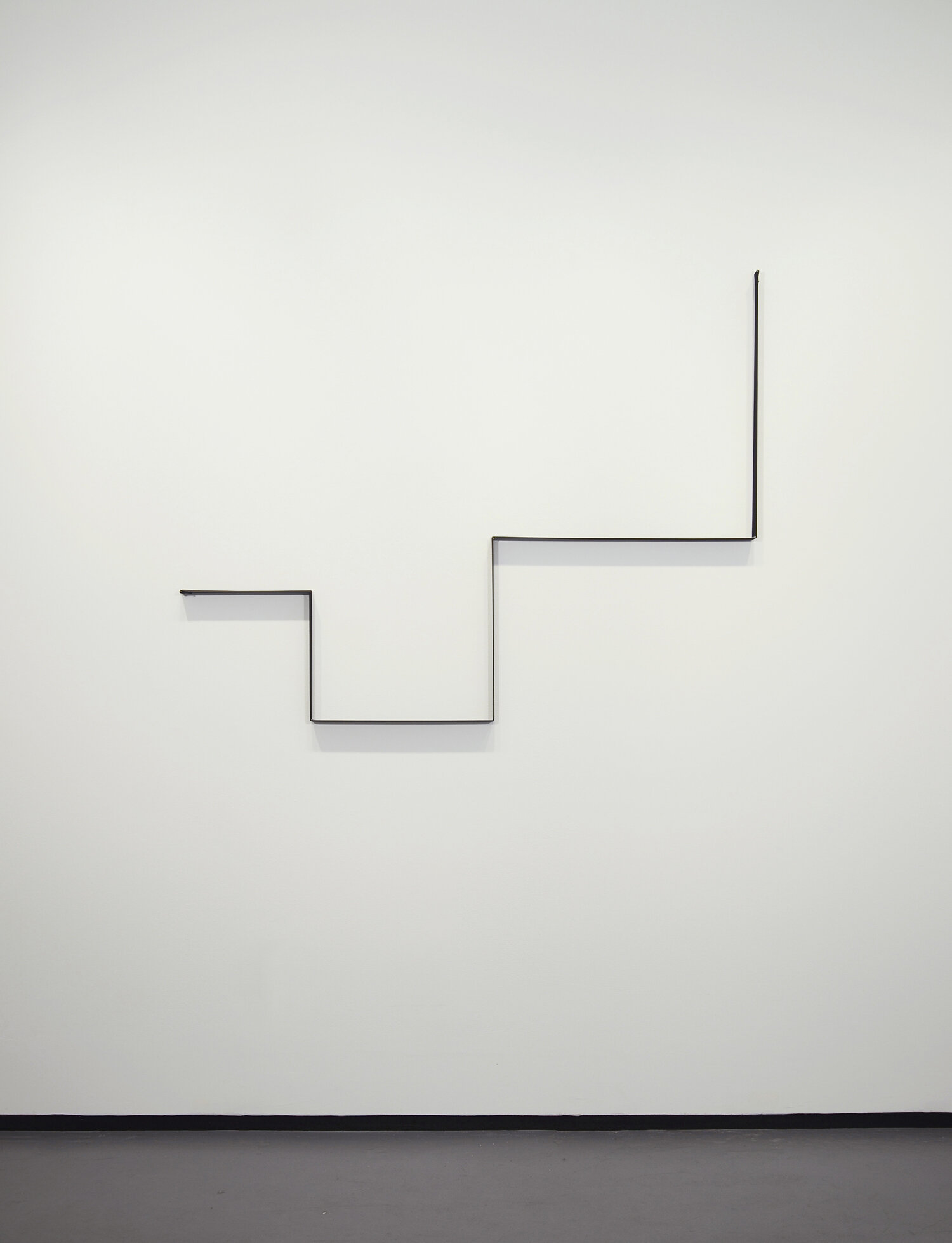Hartmut Böhm
b. 1938 Kassel, Germany / d. 2021 Berlin, Germany
Interested in Hartmut Böhm? Contact us.
Hartmut Böhm, Exchange – Funny Red Line, 2014, White matboard, red colored pencil on wall, 24 x 79 inches, #HB40
Hartmut Böhm, Exchange – Funny Red Line, 2014, White matboard, red colored pencil on wall, 24 x 79 inches, #HB40
Hartmut Böhm, Exchange – Funny Red Line (detail), 2014, White matboard, red colored pencil on wall, 24 x 79 inches, #HB40
Hartmut Böhm, Figure, 1998, 10 constellations from 10 drawings, elastic band, nails, Dimensions variable, Edition 5 of 30, #HB37
Hartmut Böhm, Figure, 1998, 10 constellations from 10 drawings, elastic band, nails, Dimensions variable, Edition 5 of 30, #HB37
Hartmut Böhm, Wall Work from the Measurements of a Progression to Infinity with 15°, 1996-2014, Wooden frame, plexiglas, off-white matboard, oil stick on wall, 93 x 93 inches, #HB38
Hartmut Böhm, Wall Work from the Measurements of a Progression to Infinity with 15° (detail), 1996-2014, Wooden frame, plexiglas, off-white matboard, oil stick on wall, 93 x 93 inches, #HB38
Hartmut Böhm, Untitled, 1980-2014, Wooden frame, plexiglas, matboard, 24 x 24 inches, #HB39
Hartmut Böhm, Großzügig, 2013, Pencil and glaze on Fabriano paper, 30 x 22 inches / 76 x 56 cm, #HB31
Hartmut Böhm, Parallel, 2013, Pencil and glaze on Fabriano paper, 30 x 22 inches / 76 x 56 cm, #HB26
Hartmut Böhm, Schrägkreuz, 2013, Pencil and glaze on Fabriano paper, 30 x 22 inches / 76 x 56 cm, #HB27
Hartmut Böhm, Zwei Hälften, 2013, Pencil and glaze on Fabriano paper, 30 x 22 inches / 76 x 56 cm, #HB32
Hartmut Böhm, Gerade/Schräg, 2013, Pencil and glaze on Fabriano paper, 30 x 22 inches / 76 x 56 cm, #HB28
Hartmut Böhm, Elegant Fallend, 2013, Pencil and glaze on Fabriano paper, 30 x 22 inches / 76 x 56 cm, #HB30
Hartmut Böhm, Außen/Innen, 2013, Pencil and glaze on Fabriano paper, 30 x 22 inches / 76 x 56 cm, #HB33
Hartmut Böhm, Fallend/Steigend, 2013, Pencil and glaze on Fabriano paper, 30 x 22 inches / 76 x 56 cm, #HB29
Hartmut Böhm, Ohne Titel (ID-9/05), 2005, Pencil and glaze on Fabriano watercolor paper, 28 x 20 inches, #HB05
Hartmut Böhm, Ohne Titel (ID-18/05), 2005, Pencil and glaze on Fabriano watercolor paper, 28 x 20 inches, #HB07
Hartmut Böhm, Ohne Titel (ID-19/05), 2005, Pencil and glaze on Fabriano watercolor paper, 28 x 20 inches, #HB08
Hartmut Böhm, Ohne Titel (ID-11/05), 2005, Pencil and glaze on Fabriano watercolor paper, 28 x 20 inches, #HB06
Hartmut Böhm, Ohne Titel (ID-20/05), 2005, Pencil and glaze on Fabriano watercolor paper, 28 x 20 inches, #HB09
Hartmut Böhm, Ohne Titel (ID-21/05), 2005, Pencil and glaze on Fabriano watercolor paper, 28 x 20 inches, #HB10
Hartmut Böhm, Gegenüberstellung, horizontale farbige Linien, eng, Grey Green_Copper (ID-21_04), 2004, Colored pencil on Fabriano watercolor paper, framed, 15 x 12 inches, #HB03
Hartmut Böhm, Farbklima, 1997, Colored pencil on Fabriano watercolor paper, 28 x 20 inches, #HB02
Hartmut Böhm, Gegenüberstellung, vertikale Linien, eng, Faber Castell H und HB (ID 51-03), 2003, Pencil on Fabriano watercolor paper, 14 x 20 inches, #HB04
Biography
Hartmut Böhm is a leading proponent of European Concrete art and one of the most influential reductive artists of his generation. Born in Kassel, Germany in 1938, he studied at Hochschule für Bildende Künste with Arnold Bode, founder and curator of Documenta. Böhm produced his first systems-based work in 1959. Several years later, his work was included in the seminal exhibition Nouvelle Tendance: Propositions visuelles du mouvement international at the Musée des Arts Décoratifs in Paris, France in 1964. The exhibition heralded in the new Op, Kinetic, Concrete, Zero, GRAV, Gruppo T and Gruppo N art movements and highlighted works that addressed the concept of movement as conveyed through serial repetition.
Böhm has mounted more than seventy solo and two-person exhibitions since 1964 and has participated in hundreds of group exhibitions at museums, galleries and non-profits internationally. His work is included in seventy public collections worldwide, including the Neuberger Museum of Art (Purchase, NY); Busch-Reisinger Museum, Harvard University (Cambridge, MA); Josef Albers Museum (Bottrop, Germany); Städtisches Kunstmuseum (Bonn, Germany); Karl Ernst Osthaus Museum (Hagen, Germany); Museum für konkrete Kunst (Ingolstadt, Germany); Albertinum der Staatlichen Kunstsammlung (Dresden, Germany); Wilhelm-Hack-Museum (Ludwigshafen, Germany); Pinakothek der Moderne, Städtische Galerie im Lenbachhaus (Munich, Germany); Stiftung für konkrete Kunst (Reutlingen, Germany); Museum Ritter (Waldenbuch, Germany); Donation Albers-Honegger (Mouans-Sartoux, France); Musée Matisse (Le Cateau-Cambrésis, France); Louisiana Museum for Moderne Kunst (Humlebæk, Denmark); Muzeum Sztuki (Lodz, Poland); Haus für konstruktive und konkrete Kunst (Zürich, Switzerland); Richard Paul Lohse-Stiftung (Zürich, Switzerland); Mondriaanhuis (Amersfoort, The Netherlands); Museum Moderner Kunst Stiftung Ludwig (Vienna, Austria); and Tel Aviv Museum of Art (Tel Aviv, Israel), among many others.
Overview
For more than fifty years, Hartmut Böhm has been working in a variety of media, including installation, sculpture, drawing, and printmaking. His work focuses almost exclusively on the aesthetics of systems that highlight the relativity of perception and his practice is organized around four primary areas of investigation: Systems (serial structures), Perception (transparency and visual ambiguity), Gestalt (partition and outline), and Concept (linear principles and infinite progressions).
Gallery Exhibitions
Twenty, June 24 - September 30, 2023
Untitled (Summer), July 19 - August 24, 2019
On Paper, July 9 – August 13, 2016
Hartmut Böhm: Wall Works, June 28 – August 2, 2014
Hartmut Böhm: Graphic Systems, Prints 1965-1975, May 8 – June 12, 2010
Open House for Butterflies, July 31 – August 29, 2009
MINUS SPACE, curated by Phong Bui, MoMA PS1, NYC, October 19, 2008 – May 4, 2009
Videos
Hartmut Böhm, HF20, 1968

























